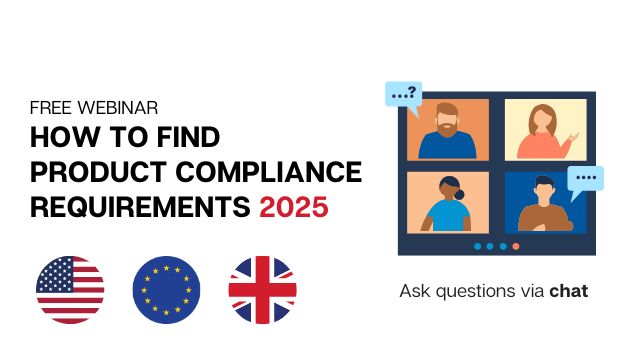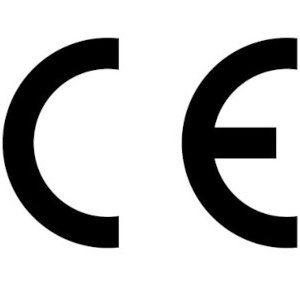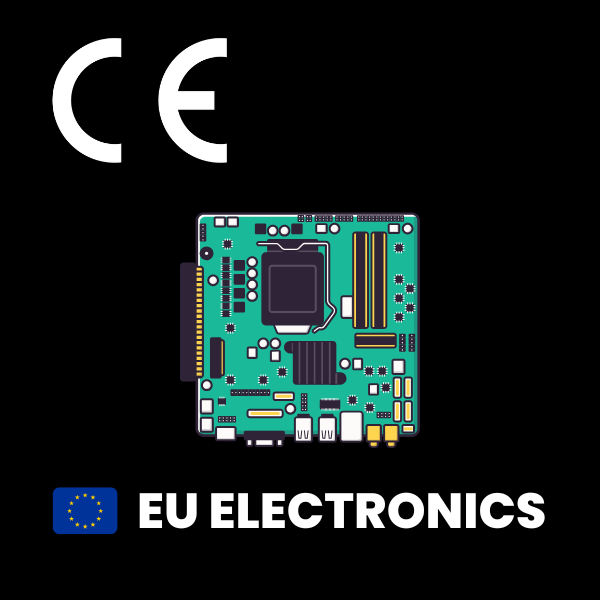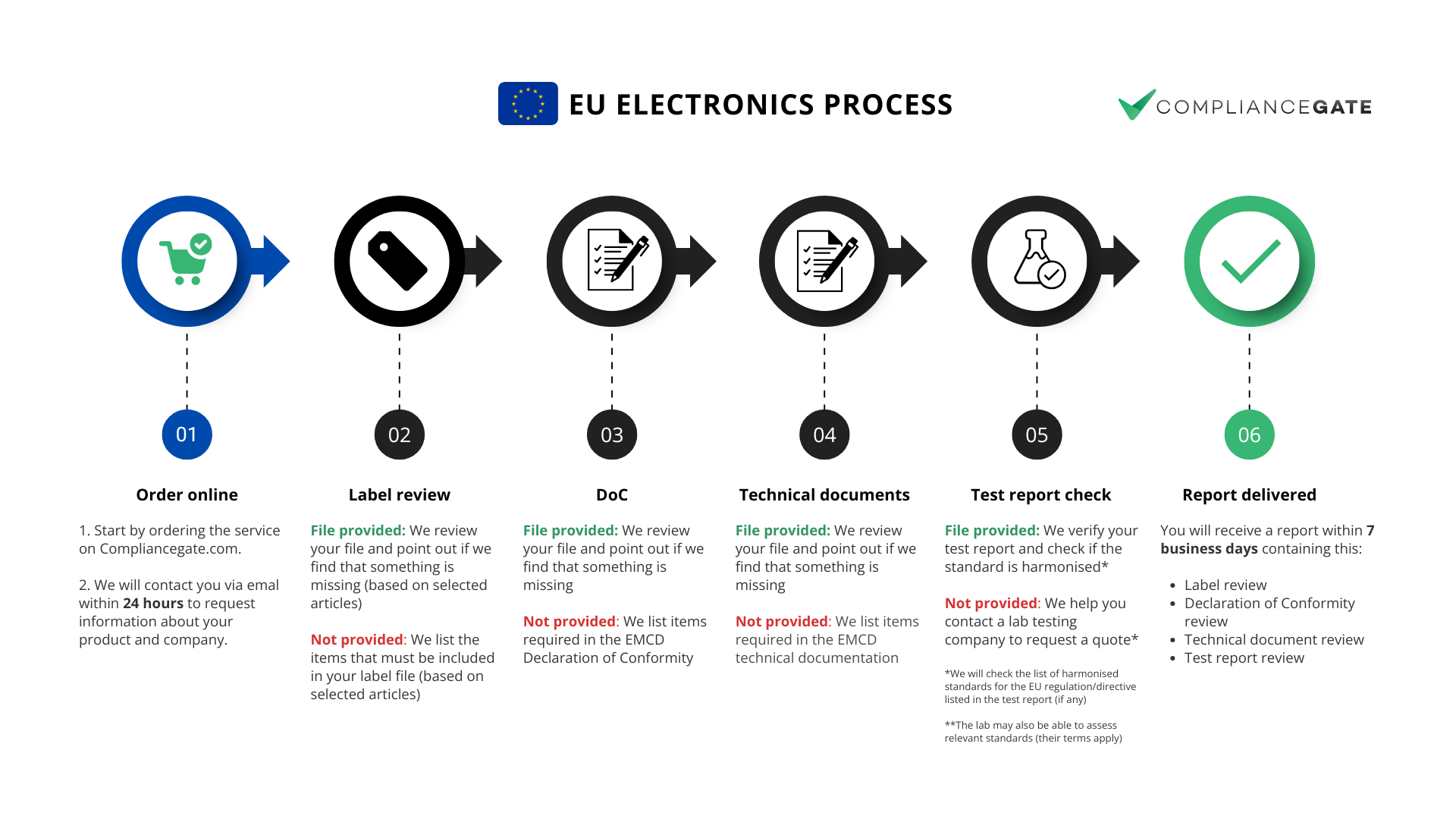EU Electronics Check
We review your label files, documentation, and test reports based on selected articles in the EU Electromagnetic Compatibility Directive 2014/30/EU*. You will receive a report within 7 business days.
-

CE mark and traceability label review -

EU Declaration of Conformity (DoC) review -

Technical documentation review -

Test report review
*We also check certain parts from other regulations/directives. You can find more information in the service scope below.
GET 40% OFF UNTIL FRIDAY
The discount is applied automatically in the checkout.
Order now (USD 299.4 (USD 499))
Product examples
This service is relevant for products covered by the Electromagnetic Compatibility Directive 2014/30/EU (consolidated version from 11/09/2018):

Article 2 – Scope
1. This Directive shall apply to equipment as defined in Article 3.
Article 3 – Definitions
1. For the purposes of this Directive, the following definitions shall apply:
(1) ‘equipment’ means any apparatus or fixed installation;
(2) ‘apparatus’ means any finished appliance or combination thereof made available on the market as a single functional unit, intended for the end-user and liable to generate electromagnetic disturbance, or the performance of which is liable to be affected by such disturbance;
(3) ‘fixed installation’ means a particular combination of several types of apparatus and, where applicable, other devices, which are assembled, installed and intended to be used permanently at a predefined location;

Service scope: This service is based on the following articles:
Electromagnetic Compatibility Directive 2014/30/EU (consolidated version from 11/09/2018): Article 7(5), Article 7(6), Article 9(3), Article 17(1), Article 18, ANNEX IV and ANNEX II(3).
Low Voltage Directive 2014/35/EU (Legal Act): Annex I(1a)
WEEE Directive 2012/19/EU: Article 14(4)*
Other articles, pages, or sources are not taken into consideration.
*We only check the presence of the WEEE symbol in Annex IX.
Note: We verify test reports related to the following as part of the process: Electromagnetic Compatibility Directive 2014/30/EU, RoHS Directive 2011/65/EU, Low Voltage Directive 2014/35/EU, Radio Equipment Directive 2014/53/EU, Batteries Regulation (EU) 2023/1542, Ecodesign Directive 2009/125/EC
Note: We only check if a certain file item is present (i.e., a company name that is indicated as the manufacturer). However, we cannot verify if this data is correctly specified (i.e., the actual name of the manufacturer). Here are some other examples:
a. Some regulations may specify that “installation instructions” is required. If so, we can only assess if such instructions are present. We cannot determine if these are correct as this would require product specific knowledge that we do not have.
b. Some regulations may require technical documentation that includes product drawings or risk assessments. We can only assess if such information is present. We cannot determine if the drawings or risk assessments are accurate.
FAQ
What is the purpose of this service?
1. This service can help you understand if your label files, declaration of conformity, technical documentation, and test reports comply with certain parts of the Electromagnetic Compatibility Directive.
2. We also take selected parts from other EU regulations and directives into consideration (see service scope above).
3. We check test reports corresponding to various EU regulations and directives relevant to electronic products (see service scope above)
What is this service based on?
This service is based on the specified articles of the listed EU regulations and directives. No other articles, parts, regulations, directives, guidance pages, documents, standards, or other information are taken into consideration.
What do I need to start the process?
We will contact you to request the following information once you have placed your order:
- Product information
- Company information
- Label file
- Document file
- Test reports
What if I don’t have all the files?
In that case we will review what we have. However, we will still list items that can be useful when creating your own files.
For example, if you do not have a label file, we will still include items from the covered articles/regulations/parts in the report. This can be useful when creating your own label files.
What do I receive after the process is completed?
You will receive a report that will help you understand the following:
- What is correct
- What is missing
In some cases, we also specify recommended actions.
How many products do you review?
We review files and information for a single product per service order.
How long does the process take?
Normally 7 business days from the time we have received all the requested information. Note that a delay in providing the required information will also result in a delayed delivery.
Does this service cover all EU regulations and directives for electronic products?
No, this service is primarily based on the Electromagnetic Compatibility Directive. There are many other regulations and directives applicable to electronic products in the EU. Here are some examples:
- RoHS Directive 2011/65/EU
- Low Voltage Directive 2014/35/EU
- Radio Equipment Directive 2014/53/EU
- Batteries Regulation (EU) 2023/1542
- Ecodesign Directive 2009/125/EC
- Energy Labelling Framework Regulation (EU) 2017/1369
- Cyber Resilience Act (Regulation (EU) 2024/2847)
- Waste Electrical and Electronic Equipment Directive 2012/19/EU
Unless specified on this page, we do not take these into consideration as part of the review process.
Why don’t you cover all EU regulations and directives for electronic products?
That would drastically increase the workload and therefore increase the cost of this service. Ultimately, it is up to you to decide if you deem the price and value of this service to be acceptable, despite its limitations.
Why is the service primarily based on the Electromagnetic Compatibility Directive?
There are several reasons for this:
1. The Electromagnetic Compatibility Directive is applicable to most electronic products
2. Many of the labelling and documentation requirements found in the Electromagnetic Compatibility Directive are similar to those in other regulations and directives.
As such, the Electromagnetic Compatibility Directive is often a good starting point.
Do you compare the files and information to all Electromagnetic Compatibility Directive requirements?
No, we do not compare your files to the entirety of the Electromagnetic Compatibility Directive.
Which parts of the Electromagnetic Compatibility Directive are covered in the check?
The specific articles the service is based on can be found on this page. We also specify the articles and provide source texts in the report.
Why is the check only based on parts of the Electromagnetic Compatibility Directive?
If the service was based on a review covering the entire Electromagnetic Compatibility Directive, then the process would be many times more time consuming. This would also result in a significantly increased price.
We have selected parts of the Electromagnetic Compatibility Directive that we know manufacturers and importers often get wrong. That being said, we do not claim that the review is based on the entire regulation. This means that other requirements in the regulation can still apply to your product, even though these are not mentioned or referenced in the report.
Do you guarantee or certify compliance with the Electromagnetic Compatibility Directive?
No, we do not guarantee or certify products as compliant with the Electromagnetic Compatibility Directive. We do not conduct a physical evaluation or testing process of the product. Further, we only review and check the files and information provided.
Further, we operate based on the assumption that testing companies provide a truthful verification of test reports upon request.
Will this report become outdated at some point?
Yes, regulations can be amended or even replaced by entirely new legislation. For example, the articles/regulations/parts that the review process is based on can be subject to change.
Note that we always specify which version of the regulation the report is based on.
























